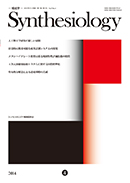Volume 7, Issue 4
Displaying 1-10 of 10 articles from this issue
- |<
- <
- 1
- >
- >|
Research papers
-
2014 Volume 7 Issue 4 Pages i
Published: 2014
Released on J-STAGE: March 14, 2015
Download PDF (520K) -
2014 Volume 7 Issue 4 Pages 211-219
Published: 2014
Released on J-STAGE: March 14, 2015
Download PDF (3323K) -
2014 Volume 7 Issue 4 Pages 220-227
Published: 2014
Released on J-STAGE: March 14, 2015
Download PDF (2481K) -
2014 Volume 7 Issue 4 Pages 228-237
Published: 2014
Released on J-STAGE: March 14, 2015
Download PDF (6098K) -
2014 Volume 7 Issue 4 Pages 238-246
Published: 2014
Released on J-STAGE: March 14, 2015
Download PDF (3333K) -
2014 Volume 7 Issue 4 Pages 247-257
Published: 2014
Released on J-STAGE: March 14, 2015
Download PDF (2632K)
Editorial board
-
2014 Volume 7 Issue 4 Pages 259-260
Published: 2014
Released on J-STAGE: March 14, 2015
Download PDF (300K) -
2014 Volume 7 Issue 4 Pages 261-262
Published: 2014
Released on J-STAGE: March 14, 2015
Download PDF (305K) -
2014 Volume 7 Issue 4 Pages 269-270
Published: 2014
Released on J-STAGE: March 14, 2015
Download PDF (355K)
Letter from the editor
-
2014 Volume 7 Issue 4 Pages 271
Published: 2014
Released on J-STAGE: March 14, 2015
Download PDF (408K)
- |<
- <
- 1
- >
- >|
